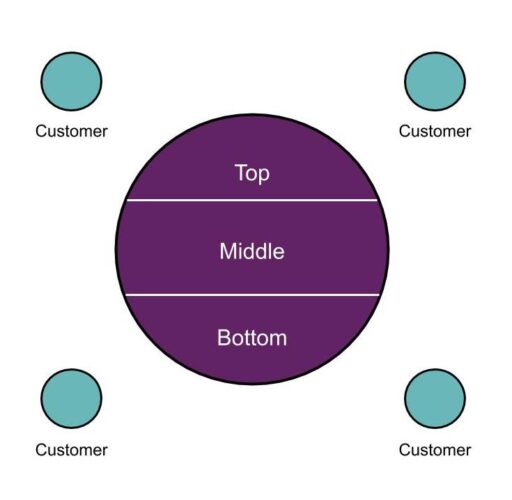Power + Systems is the work of Barry Oshry, it’s a model that helps you better see why problems arise within your organisation, and this understanding helps you do something about it.
What Barry Oshry realised was that many problems are not, in fact, personal. Instead, they are systemic, meaning that they are shaped by the situations that we work in, relative to each other.
If you can challenge the invisible underlying system, it can produce surprising results.
I really like this idea, and I have a good story about how I came across this model and the thinking behind it.
Power + Systems: an example in action
Two years ago I was invited by RedQuadrant – a consultancy who work with local authorities in the UK – to a workshop they were running. I’ve known RedQuadrant’s founder Benjamin Taylor for years and years, in fact, I went to college with him.
At the time Benjamin had just come back from training in America with Barry Oshry and was running open workshops (more accurately, simulations) in London. I went along because I was curious.
When I arrived I was handed an envelope, inside was a piece of paper with one word on it: Bottom.
It transpired that other people had ‘Middle’ or ‘Top’ on their bit of paper. Some people had ‘Customer’.
The idea of the day was that we were going to simulate an organisation, and the bits of paper signified our roles in the organisation.
There were a few rules. For example as a Bottom, I had to take off my shoes. No other role had to. It was a status thing: Bottoms were metaphorically given cold feet. (I really did get cold feet, which was quite annoying!)
All Bottoms went downstairs, where we formed into teams, and were assigned a Middle who was our middle manager who’d tell us what we were going to do.
The Tops, the senior managers, were upstairs, and the Customers were somewhere else.
The facilitators said, “We’re going to run the simulation several times and iterate it during the course of the day.”
The first round started and a Middle came to us and said, “I’m going to find out what your task is, I’ll be back in a minute… Looking forward to working with you.” And off she went.
We start chatting, getting to know each other. Time is ticking by, we’re sitting around, and the Middle doesn’t show up again. We think this is curious.
Then the facilitators blow a whistle and that’s the end of the first simulation.
I’m thinking that was quite bewildering. But okay, I’m going with it.
A short while later we restart the simulation. Our Middle comes bustling down and says, “Really sorry, I got caught up in stuff, there was loads going on and I couldn’t get away. There wasn’t any clarity, and I was trying to sort it all out and then we got called over to a different place. Anyway, it’s going to be to do with magazines. I’ll be back in a minute.”
And off she went.
And… she didn’t come back. Again!
This time my group start grumbling, “This is a bit rubbish, what’s going on? The Middles seem a bit incapable and incompetent, don’t they, bless them. Why can’t we sort our own stuff out, we could do this better couldn’t we?”
We carry on sitting there waiting to be told what to do, and having a good old moan.
After a couple of these rounds, they call everyone back together and ask about our experience of it so far.
My group say, “It’s a bit rubbish, no one seems to know what they’re doing, we’re just having our time wasted, we’re not having a great time.”
The Middles say, “We’re really sorry, we’re stretched in all different directions and it’s really hard to keep everybody happy.”
The Tops say, “We know it’s all our fault, but you have no idea how complicated it is – we’re trying to balance a whole bunch of conflicting agendas. Every time we’ve got it steady a new piece of information comes in, you just don’t know how hard this job is.”
The Customers say, “We had a really good initial meeting but now we think you guys are idiots. We’re a bit bewildered and we aren’t really engaged in this process.”
Then Benjamin gets up on stage and shows us all a slide which explains that Power + Systems simulations have been run all over the world thousands of times, and people always exhibit the same behaviour:
- Bottoms always make the assumption that everyone else is an idiot and they could do better. But they don’t do anything. They adopt a victim, done-to mentality.
- Middles get caught up in the middle of everything, trying to keep everybody happy, get stretched really thin and find it really uncomfortable, and don’t move things forward.
- Tops suck it all up, hold everything really close and don’t let anything down, they just carry the burden and don’t let anybody help them.
- Customers disengage and have a really bad experience.

What Barry Oshry’s Power + Systems shows is that these patterns are universal. They crop up repeatedly. Every time a large group of people get together, these patterns emerge.
The Power + Systems simulation shows how we’re all pre-programmed: if you give human beings a certain set of conditions, you can predict what the default responses will be.
As Bottoms we were definitely embracing our victimhood. We didn’t do anything about it. We were quite happy to revel in that way of thinking.
There’s more.
Lunchtime comes and Benjamin says, “All the Tops, please join me at the top table for a three-course hot meal… Bottoms sit on the benches at the back, get yourself a supermarket sandwich and a bag of crisps.”
We all have our lunch.
Afterwards, Benjamin asks, “How do you feel about that?” We, of course, say it wasn’t that great.
“Here’s the thing,” he says, “we had enough food at the top table for everyone, but not one person challenged me on it. Not one person came up here or grabbed a plate and helped yourself. All of you completely accepted the system.”
Even when we knew what the game was, we still defaulted to our pre-programmed responses.
By the end of the day, after several iterations, we understood the point and all the Bottoms begin walking around, asking, “What can we do?”, “How can we help?” We start taking control, doing things, speaking to customers, and so much more.
The point of the simulation is that once you realise the patterns you’re in, it gives you options about alternative behaviour.
And once we realised that, there was a lot more buzz, we had a lot more energy, and we were all a lot more engaged.
Yes, it was a ‘simulation’, but if you can create that awareness in your organisation, if you can persuade enough people to participate at work in a different way, what consequences might that have – for staff retention, progress, and the work that you do?
Bottoms could’ve found some Middles and asked them, “What can we do? How can we help?”
Equally the Middles could’ve invited us up – they were upstairs being briefed by the Tops and then having meetings with the Customers about what they thought they wanted.
In the middle of that, the scenario changed, with new information and before they knew what they were doing the session was over.
Bottoms could’ve been talking to the Customers.
Tops could’ve been cascading the decisions down.
What You Can Learn from Power + Systems
Barry Oshry showed that in all organisations, regardless of how big they are, everyone is subject to the embedded patterns within that system. The system acts on us in invisible ways.
If you look, you can start to see the programming wherever you go – the same traps, behaviours, and unacknowledged assumptions about the reality that’s been created, and about what you can and can’t do.
Why This Tool is Good for Leaders
If you start paying attention and noticing the patterns in your organisation, if you’re wondering about a next step you can take to move something forward, you might be able to pause and reflect for a moment on what alternative steps might be.
If you follow the rules and conform, you may be maintaining dysfunctional patterns or making things worse.
But if you had no fear, no set of norms about the way ‘we do things’, what would you do?
Thinking like that gives you some agency to decide to break away from your default response. What if you do something different instead?
How about you just try it.
More info
For more info have a look at Power + Systems materials – and RedQuadrant in the UK.
Also, have a look at our blog post on Transactional Analysis and learned helplessness.
